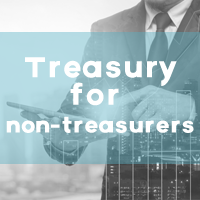Four education programs for ambitious treasurers
| 18-3-2019 | by Pieter de Kiewit |
One of our regular meeting topics is how to improve the skills of the corporate treasury population. Research for the Treasurer Test (https://www.treasuryxl.com/news-articles/treasurer-test-report-is-ready/) shows that only 20% of all treasurers completed a dedicated treasury education. I am happy I was invited to join the “Curatorium” of the Register Treasurer program of the Vrije Universiteit so I can further contribute (https://www.linkedin.com/in/pieterdekiewit/). For all people screening the (international and Dutch) treasury education market, I would like to share my thoughts about what I think are the most relevant programs, in order of investment and value:
- Recently the Hogeschool Utrecht started with a post bachelor program treasury management. In my opinion, with this program, they target an audience that just started working in treasury as well as a group of financials that only occasionally deals with the profession like (group) controllers, entrepreneurs, CFOs, auditors and others. It’s a great introduction program, the investment in time and money is overseeable. What I like is the fact they teach class in groups, so you can also learn from your peers. Teachers combine academic and practical experience https://www.treasuryxl.com/news-articles/hogeschool-utrecht-start-post-hbo-cursus-treasury-management/
- The Certified Treasury Professional (CTP) program from the US is starting to get traction in Europe too. The reviews I get from treasurers who completed the program are a bit mixed, I believe it offers good value for money and the title behind your name is appreciated by the labour market. I did not yet hear if the difference between corporate treasury in the US and Europe has an impact on the program. Studying and the final tests are done online so you do need discipline to complete this program.
- The treasury training programs of the ACT are best known in (and outside) Europe and appreciated by hiring managers. There are various modules, all together the program is more comprehensive than the one of the CTP. You also have to study and do tests online and the titles behind your name are a plus.
- The most comprehensive and thorough program I know is the one taught at the Vrije Universiteit in Amsterdam: https://www.treasuryxl.com/community/companies/vrije-universiteit-amsterdam/. The post academic degree Treasury Management and Corporate Finance already exists over 20 years. In time and money, this program requires serious investment and brings the RT title behind your name. In my opinion there are two prominent differences, when compared to the previous programs. First, classes are taught at the university to stable groups. This creates a thorough exchange of thoughts and groups of alumni that know how to find each other for many years. Second, not only there is more knowledge transferred, also students are expected to digest and build upon this knowledge in an academic way.
I hope you can benefit from this overview and I do appreciate reactions. I want to wrap up with a consideration that perhaps deserves an extra blog. The above mentioned institutes have a variety of goals that partly overlap. I wonder if the profit and sales focus of some of them are in conflict with a focus on high quality education. What do you think?

Pieter de Kiewit
Owner Treasurer Search





 In the financial industry an option is an instrument, based on financial derivatives, that enable the buyer of the option to obtain the right, but not the obligation, to buy or sell an underlying product/asset at an agreed price on or before a certain date in the future. As simple descriptions go, this requires a lot of understanding about different subjects. It is the intention of this article to clearly explain all the terms mentioned above.
In the financial industry an option is an instrument, based on financial derivatives, that enable the buyer of the option to obtain the right, but not the obligation, to buy or sell an underlying product/asset at an agreed price on or before a certain date in the future. As simple descriptions go, this requires a lot of understanding about different subjects. It is the intention of this article to clearly explain all the terms mentioned above. Op donderdagavond 14 december 2017 vindt er een Extra Voorlichtingsavond plaats voor de Postgraduate opleiding Treasury Management & Corporate Finance, aan de Vrije Universiteit Amsterdam. Dit is de laatste kans voor geïnteresseerden in de opleiding die het programma in het Nederlands willen volgen.
Op donderdagavond 14 december 2017 vindt er een Extra Voorlichtingsavond plaats voor de Postgraduate opleiding Treasury Management & Corporate Finance, aan de Vrije Universiteit Amsterdam. Dit is de laatste kans voor geïnteresseerden in de opleiding die het programma in het Nederlands willen volgen.
 Both from student perspective as well as from educators we receive signals they want to invest in training and education. Some articles have been written about what is out there (read
Both from student perspective as well as from educators we receive signals they want to invest in training and education. Some articles have been written about what is out there (read  It has always been our mission to promote Treasury as a profession and to increase the awareness of Treasury within business. Currently there are more education choices for students to study and appreciate Treasury, but we still felt there was a gap – knowledge for anyone who was genuinely interested in learning more about Treasury.
It has always been our mission to promote Treasury as a profession and to increase the awareness of Treasury within business. Currently there are more education choices for students to study and appreciate Treasury, but we still felt there was a gap – knowledge for anyone who was genuinely interested in learning more about Treasury.
